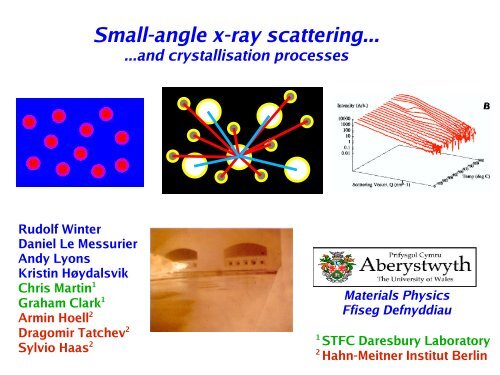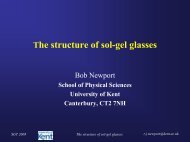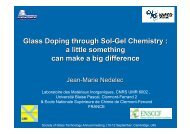Small-angle x-ray scattering...
Small-angle x-ray scattering...
Small-angle x-ray scattering...
You also want an ePaper? Increase the reach of your titles
YUMPU automatically turns print PDFs into web optimized ePapers that Google loves.
Rudolf Winter<br />
Daniel Le Messurier<br />
Andy Lyons<br />
Kristin Høydalsvik<br />
Chris Martin 1<br />
Graham Clark 1<br />
Armin Hoell 2<br />
Dragomir Tatchev 2<br />
Sylvio Haas 2<br />
<strong>Small</strong>-<strong>angle</strong> x-<strong>ray</strong> <strong>scattering</strong>...<br />
...and crystallisation processes<br />
Materials Physics<br />
Ffiseg Defnyddiau<br />
1 STFC Daresbury Laboratory<br />
2 Hahn-Meitner Institut Berlin
<strong>Small</strong>-<strong>angle</strong> x-<strong>ray</strong> <strong>scattering</strong><br />
Anomalous SAXS<br />
Nanoscale refractory analogue<br />
- Gelation & Calcination<br />
- Sintering
flight tube<br />
sample<br />
position<br />
x-<strong>ray</strong>s from<br />
storage ring<br />
A small-<strong>angle</strong> x-<strong>ray</strong> <strong>scattering</strong> camera<br />
e.g.: HMI SAXS beamline at Bessy, Berlin<br />
detector
<strong>Small</strong>-<strong>angle</strong> <strong>scattering</strong> vs. diffraction<br />
k<br />
��<br />
k'<br />
q=k'-k<br />
q = (4���� sin�<br />
x-<strong>ray</strong>s scatter from electrons<br />
neutrons scatter from nuclei<br />
and magnetic moments<br />
diffraction small-<strong>angle</strong> <strong>scattering</strong><br />
- <strong>scattering</strong> from atomic structures<br />
- size of objects ~ �<br />
- small length scale -> large <strong>angle</strong><br />
- <strong>scattering</strong> from interfaces<br />
- size of objects >> �<br />
- large length scale -> small <strong>angle</strong>
SAXS and particle size
SAXS and particle size
Guinier regime<br />
What can we learn from a SAXS pattern?<br />
Porod slope<br />
at larger q<br />
q -n where n<br />
represents the<br />
surface morphology<br />
n=4: smooth<br />
3
<strong>Small</strong>-<strong>angle</strong> x-<strong>ray</strong> <strong>scattering</strong><br />
Anomalous SAXS<br />
Nanoscale refractory analogue<br />
- Gelation & Calcination<br />
- Sintering
Anomalous SAXS<br />
Resonant <strong>scattering</strong> and absorption<br />
atomic <strong>scattering</strong> factor:<br />
f(q,E) = f 0 (q) + f '(q,E) + jf ”(q,E)<br />
scattered intensity ~ f 2 2<br />
= f + 2f0f ' + (f '<br />
0<br />
2 +f ” 2 )<br />
normal SAXS<br />
correlations btw. edge element & others<br />
correlations between labelled phases only<br />
Side effects...<br />
... not entirely unwanted!<br />
● experiment at 18keV<br />
-> compressed q scale<br />
● difference patterns reveal<br />
which features are due to edge<br />
element even if partial <strong>scattering</strong><br />
functions cannot be computed
● photon energy calibrated to<br />
Zr foil at 17.993keV<br />
● 8eV chemical shift of edge in<br />
unreacted sample<br />
● edge shifts by several eV as<br />
reaction progresses<br />
Chemical contrast<br />
ASAXS:<br />
3 energies below the edge<br />
=> determine partial<br />
structure factors<br />
but: chemical edge shift
● photon energy calibrated to<br />
Zr foil at 17.993keV<br />
● 8eV chemical shift of edge in<br />
unreacted sample<br />
● edge shifts by several eV as<br />
reaction progresses<br />
Chemical contrast<br />
Energy-dependent SAXS:<br />
compare above/below edge<br />
=> maximum contrast with<br />
little uncertainty w.r.t. chemical<br />
shifts<br />
but: fluorescence
1. Absorption measurement<br />
gives f":<br />
f"(E) ~ E µ(E)<br />
2. Extend the measured range<br />
according to tabulated data<br />
3. Kramers-Kronig transform<br />
gives f':<br />
Finding the resonance
<strong>Small</strong>-<strong>angle</strong> x-<strong>ray</strong> <strong>scattering</strong><br />
Anomalous SAXS<br />
Nanoscale refractory analogue<br />
- Gelation & Calcination<br />
- Sintering
Precursors and ceramics under heat load<br />
How do particles in a ceramic<br />
bond to the matrix?<br />
annealing<br />
reactive<br />
sintering
<strong>Small</strong>-<strong>angle</strong> x-<strong>ray</strong> <strong>scattering</strong><br />
Anomalous SAXS<br />
Nanoscale refractory analogue<br />
- Gelation & Calcination<br />
- Sintering
1. Gelation.<br />
Zr(OiPr) 4 + 4 H 2 O = Zr(OH) 4 + 4 iPrOH<br />
In-situ SAXS experiment<br />
at Daresbury - 6.2<br />
0.1 1. q / nm 10.<br />
-1<br />
Making a sol-gel ceramic
1. Gelation.<br />
Zr(OiPr) 4 + 4 H 2 O = Zr(OH) 4 + 4 iPrOH<br />
beamstop<br />
0.1 1. q / nm 10.<br />
-1<br />
2. Drying.<br />
structure<br />
factor<br />
macro<br />
scatterers<br />
Making a sol-gel ceramic<br />
individual<br />
scatterers<br />
Zr(OH) 4 = ZrO 2 ∙ 2 H 2 O and polymerisation<br />
3. Calcination.<br />
ZrO 2 ∙ 2 H 2 O = ZrO 2 + 2 H 2 O and crystallisation<br />
10. q / nm 50.<br />
-1<br />
Polymerisation precedes crystallisation.<br />
Nuclei form at room temperature,<br />
crystallisation requires ~800 o C to activate.
<strong>Small</strong>-<strong>angle</strong> x-<strong>ray</strong> <strong>scattering</strong><br />
Anomalous SAXS<br />
Nanoscale refractory analogue<br />
- Gelation & Calcination<br />
- Sintering
In-situ sintering experiments at Daresbury-6.2<br />
● fast tunable monochromator<br />
● energy up to 18keV (Zr-K edge)<br />
● Rapid detector family<br />
● pellet furnace (to 1100 o C)<br />
Fig. from CC Tang et al., Nucl. Instr. Meth.<br />
Phys. Res. B222 (2004) 659<br />
T/ o C<br />
300<br />
275<br />
250<br />
0 2 5 10 1517<br />
time<br />
each temperature step (17min) comprises:<br />
ramp at 12.5K/min (2min)<br />
equilibration (3min)<br />
18.02keV experiment (5min)<br />
18.05keV experiment (5min)<br />
17.98eV experiment (90s)
In-situ sintering experiments at Daresbury-6.2<br />
0.1 1 4<br />
350C<br />
725C
Guinier regime<br />
What can we learn from a SAXS pattern?<br />
Porod slope<br />
at larger q<br />
q -n where n<br />
represents the<br />
surface morphology<br />
n=4: smooth<br />
3
Guinier radius: matrix softening & agglomeration<br />
Littleton<br />
softening<br />
point<br />
agglomeration<br />
& densification<br />
slow<br />
growth
Porod slope: matrix softening & agglomeration<br />
below edge:<br />
zirconia-air<br />
contrast<br />
above edge:<br />
glass-air<br />
contrast<br />
above<br />
edge<br />
below<br />
edge<br />
high-T:<br />
zirconia-glass<br />
contrast
<strong>Small</strong>-<strong>angle</strong> x-<strong>ray</strong> <strong>scattering</strong><br />
Anomalous SAXS<br />
Nanoscale refractory analogue<br />
- Gelation & Calcination<br />
- Sintering
Summary: Energy-dependent SAXS<br />
Standard SAXS<br />
- characteristic length scales<br />
- interface morphology<br />
- but: messy in complex systems<br />
Difference SAXS above/below edge<br />
- chemical contrast<br />
- but: fluorescence<br />
Anomalous SAXS<br />
- partial structure factors<br />
- but: very sensitive to chemical shifts
Summary: Refractory ceramics<br />
Gelation Calcination Sintering<br />
Initial formation of a<br />
polymer network<br />
Corrosion<br />
ZrO2 component of<br />
the refractory is less<br />
prone to corrosion<br />
by K + than by Na +<br />
Polymerisation, then<br />
crystallisation<br />
glass grain surfaces<br />
becomes smoother near<br />
the softening point<br />
pores consolidate<br />
ZrO2 particles agglomerate<br />
inside the pores
Rudolf Winter<br />
Daniel Le Messurier<br />
Andy Lyons<br />
Kristin Høydalsvik<br />
Chris Martin 1<br />
Graham Clark 1<br />
Armin Hoell 2<br />
Dragomir Tatchev 2<br />
Sylvio Haas 2<br />
<strong>Small</strong>-<strong>angle</strong> x-<strong>ray</strong> <strong>scattering</strong>...<br />
...and crystallisation processes<br />
Materials Physics<br />
Ffiseg Defnyddiau<br />
1 STFC Daresbury Laboratory<br />
2 Hahn-Meitner Institut Berlin





